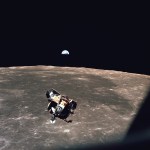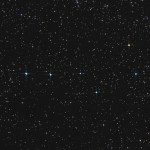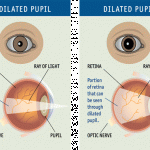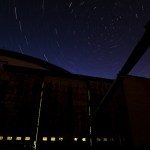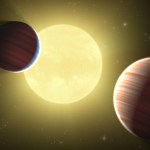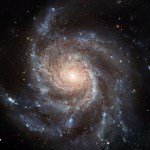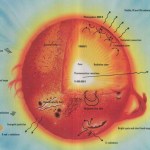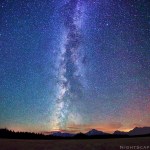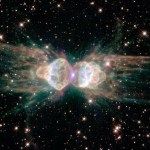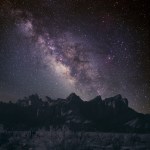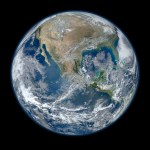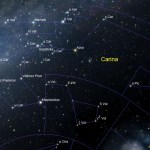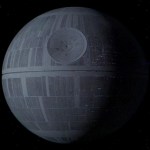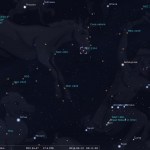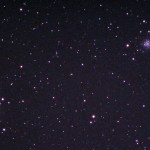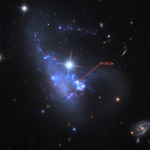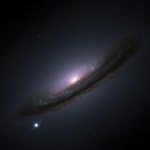Stars
"It suddenly struck me that that tiny pea, pretty and blue, was the Earth. I put up my thumb and shut one eye, and my thumb blotted out the planet Earth. I didn't feel like a giant. I felt very, very small." -Neil Armstrong
Here on our little wet rock in our Solar System, we often remind ourselves what a small world Earth actually is. The farther out in space we reach, the more this appears to be true.
Image credit: NASA / Apollo 11, taken by Command module pilot Michael Collins.
The Earth is the largest of the four inner, rocky planets in our Solar System, at more than 12,000 km in…
"I would rather be adorned by beauty of character than jewels. Jewels are the gift of fortune, while character comes from within." -Plautus
When it comes to astronomy, there's no doubt that I've got a northern hemisphere bias. It's no surprise, of course; I live here. And while I often write about the skies that we all share, astronomy has a historical bias in favor of the northern hemisphere. You know this, too. Ask most people to name one single thing in the night sky, and you're most likely going to end up with this.
Image credit: Rich Richins of http://www.enchantedskies.net/.
The Big…
"I went into a clothing store, and the lady asked me what size I was. I said, 'Actual'. I'm not to scale." -Demitri Martin
When you look out at the Universe, what you can see is limited, at the most fundamental level, by the size of what you look with. This is why you can see dimmer objects at night -- when your pupils are dilated -- than you can when your pupils are constricted.
Image credit: National Institute of Health.
This same principle that applies to your eyes applies to telescopes as well. As telescopes have grown in size, so has our ability to see deeper into the Universe, as…
"Building one space station for everyone was and is insane: we should have built a dozen." -Larry Niven
Here on the solid ground of the Earth, the Sun and Moon rise and set on a daily basis. During the hours where the Sun is invisible, blocked by the solid Earth, the stars twirl overhead in the great canopy of the night sky.
Image credit: Chris Luckhardt at flickr.
In the northern hemisphere, they appear to rotate around the North Star, while in the southern hemisphere, the stars appear to rotate about the South Celestial Pole. The longer you observe -- or for photography, the longer you…
"Everyone must leave something behind when he dies, my grandfather said. A child or a book or a painting or a house or a wall built or a pair of shoes made. Or a garden planted. Something your hand touched some way so your soul has somewhere to go when you die, and when people look at that tree or that flower you planted, you're there." -Ray Bradbury
Today is Memorial Day here in the United States, where we honor all the soldiers who have fought and fallen for our country. The peace and prosperity that I have enjoyed my entire life is because of a price paid, many times over, mostly by people…
"This seems to be the law of progress in everything we do; it moves along a spiral rather than a perpendicular; we seem to be actually going out of the way, and yet it turns out that we were really moving upward all the time." -Frances Willard
As spring gives way to summer here in the Northern Hemisphere, one of the most beloved sights of the night sky becomes ever more prominent: the Big Dipper.
(Image credit: NASA, ESA, Z. Levay (STScI) and A. Fujii.)
These seven bright stars shine high above the horizon after sunset, and will continue to do so over the rest of the Spring and all Summer…
"Through that last dark cloud is a dying star... And when it explodes, it will be reborn. You will bloom... and I will live." -The Fountain
I want to start off by letting you all know that I, myself, do not have any children of my own. I have taught children, adolescents and adults for nearly a full generation now in varying capacities, and while each learner is different, there's one science fact that universally seems to shatter each and every one of them.
Image credit: the bloggers at Dear Kugluktuk.
The fact that the Sun, our Sun, the bringer of warmth, light, energy, and the sustaining…
"Some painters transform the Sun into a yellow spot, others transform a yellow spot into the Sun." -Pablo Picasso
But the Sun will not always be a bright spot. Though it has shone for billions of years already, and will continue to shine for billions of years more, it's currently doing this by burning its hydrogen fuel -- through the fires of nuclear fusion -- into the heavier element of helium.
Image credit: retrieved from UFO et Science.
But after about 10-12 billion years total, all the hydrogen that can be burned in the core will be used up! (There will still be hydrogen in the outer…
"We were left with a picture of part of the sky with no stars or galaxies, but it still had this infrared glow with giant blobs that we think could be the glow from the very first stars." -John Mather
When you look out at the night sky, you're limited by the light pollution from your surroundings, the imperfections of our atmosphere, the light-blocking gas and dust throughout the interstellar and intergalactic medium, and the capabilities of your eyes. Still, what one can see is truly a sight to behold.
Image credit: IronRodArt - Royce Blair of NightScapePhotos.com.
What if you didn't have…
"You cannot, in human experience, rush into the light. You have to go through the twilight into the broadening day before the noon comes and the full sun is upon the landscape." -Woodrow Wilson
Without a doubt, one of the most spectacular light shows of the cosmos happens when stars burn out -- reaching the end of their normal life cycle -- and die in a great supernova explosion. We've spoken in the past about the main ways that these stars die. Either a very massive star -- something more than ten times as massive as our Sun -- reaches the end of its nuclear fuel, and its core collapses,…
"A galaxy is composed of gas and dust and stars - billions upon billions of stars."
-Carl Sagan
Perhaps the most striking feature of the night sky under truly dark conditions isn't the canopy of those thousands of points of light, but rather the expanse of the Milky Way, streaking across the entire night sky.
Image credit: Richard Payne, retrieved from astro.wisc.edu.
With an estimated 200-400 billion stars contained within our island Universe, the Milky Way is just a regular, run-of-the-mill spiral galaxy compared to the rest of what's out there.
But it's our home. And, despite the…
"To use Newton's words, our efforts up till this moment have but turned over a pebble or shell here and there on the beach, with only a forlorn hope that under one of them was the gem we were seeking. Now we have the sieve, the minds, the hands, the time, and, particularly, the dedication to find those gems--no matter in which favorite hiding place the children of distant worlds have placed them."
-Frank Drake and Dava Sobel
Looking up at the canopy of stars in the night sky, and realizing that each point of light is a star system not so unlike our own, one can't help but wonder about those…
"Day after day, day after day,
We stuck, nor breath nor motion;
As idle as a painted ship
Upon a painted ocean.
Water, water, every where,
And all the boards did shrink;
Water, water, every where,
Nor any drop to drink." -Samuel Taylor Coleridge, Rime of the Ancient Mariner
Despite the discovery of dozens of worlds -- planets and moons -- in our own Solar System, as well as hundreds (soon to spill into the thousands) of confirmed planets orbiting other stars, our Earth is still unique.
Image credit: The Suomi NPP Blue Marble, NASA / NOAA.
At least, it's unique as far as we know.
A smaller,…
"Not explaining science seems to me perverse. When you're in love, you want to tell the world." -Carl Sagan
Nothing lasts forever in this Universe, not even the seemingly timeless stars in the sky. At any moment, any one of the brilliant, twinkling points of light from across the galaxy could run out of fuel, ending its life as we know it. It's happened a number of times before in recorded history, and will no doubt happen again. With a typical supernova rate of one per galaxy per century, we've got a number of nearby potential candidates for what the next supernova to occur in the Milky Way…
"What's that star?
It's the Death Star.
What does it do?
It does Death. It does Death, buddy. Get out of my way!" -Eddie Izzard
Like it was for many people, the original, very first Star Wars movie was one of my favorites as a child. And while there was a lot to be in awe of, the idea of jetting around the Universe in your own private, gargantuan structure, free from planets, Solar Systems, and even the rest of the galaxy was simply the most amazing idea to me.
Image credit: Star Wars' Wookieepedia.
That's what I wanted: a Death Star. Of course, you know what happens to the Death Star, don'…
"What's in a name? That which we call a rose
By any other name would smell as sweet." -William Shakespeare
Up in the night sky, just a few degrees away from Orion, one of the most identifiable constellations in the winter sky, lies a cluster of newly formed stars.
Image credit: Stellarium. As always, click on all images for the highest-res version available.
5,000 light years away, this cluster of stars is loaded with the full gamut of stellar colors, from blue to white to red, and is easily visible through any astronomical tool from simple hand-held binoculars to pretty much any type of…
"The Earth's atmosphere is an imperfect window on the universe... atmospheric turbulence blurs the images of celestial objects, even when they are viewed through the most powerful ground-based telescopes." -John Bahcall
There's no doubt that the Hubble Space Telescope has given us some of the most spectacular, high resolution views of the Universe. From the most distant galaxies ever seen to stars here in our own galactic backyard, the Hubble Space Telescope has simply dwarfed anything we've been able to do from Earth's surface.
Image credit: Bill Drelling.
This is the globular cluster NGC…
"The diversity of the phenomena of nature is so great, and the treasures hidden in the heavens so rich, precisely in order that the human mind shall never be lacking in fresh nourishment." -Johannes Kepler
So said the man who, in 1604, discovered the supernova that was the last to be seen, visually, within our own galaxy. Although it's likely that two others occurred subsequently, they were not visible to human eyes, and only with powerful telescopes were their remnants discovered.
But earlier this week, the first supernova of the year was discovered, in a galaxy 25 million light years away,…
"When I had satisfied myself that no star of that kind had ever shone before, I was led into such perplexity by the unbelievability of the thing that I began to doubt the faith of my own eyes." -Tycho Brahe
When we look out at galaxies throughout the Universe, we find that every so often -- about once per century -- a bright star flares up so brightly that it can, for a brief amount of time, outshine the entire rest of the galaxy!
Image credit: SN 1994D, High-Z Supernova Search Team, HST, NASA.
What's going on, of course, is not that a star is brightening, but that the very atoms composing…
"We find them smaller and fainter, in constantly increasing numbers, and we know that we are reaching into space, farther and farther, until, with the faintest nebulae that can be detected with the greatest telescopes, we arrive at the frontier of the known Universe." -Edwin Hubble
While large parts of the internet are blacked out today, in protest of SOPA and PIPA, I could think of no better way to highlight the importance of free exchange of information on the internet than by showcasing one of the most interesting, varied and intricate objects in the entire galaxy: Messier 16, better known…
